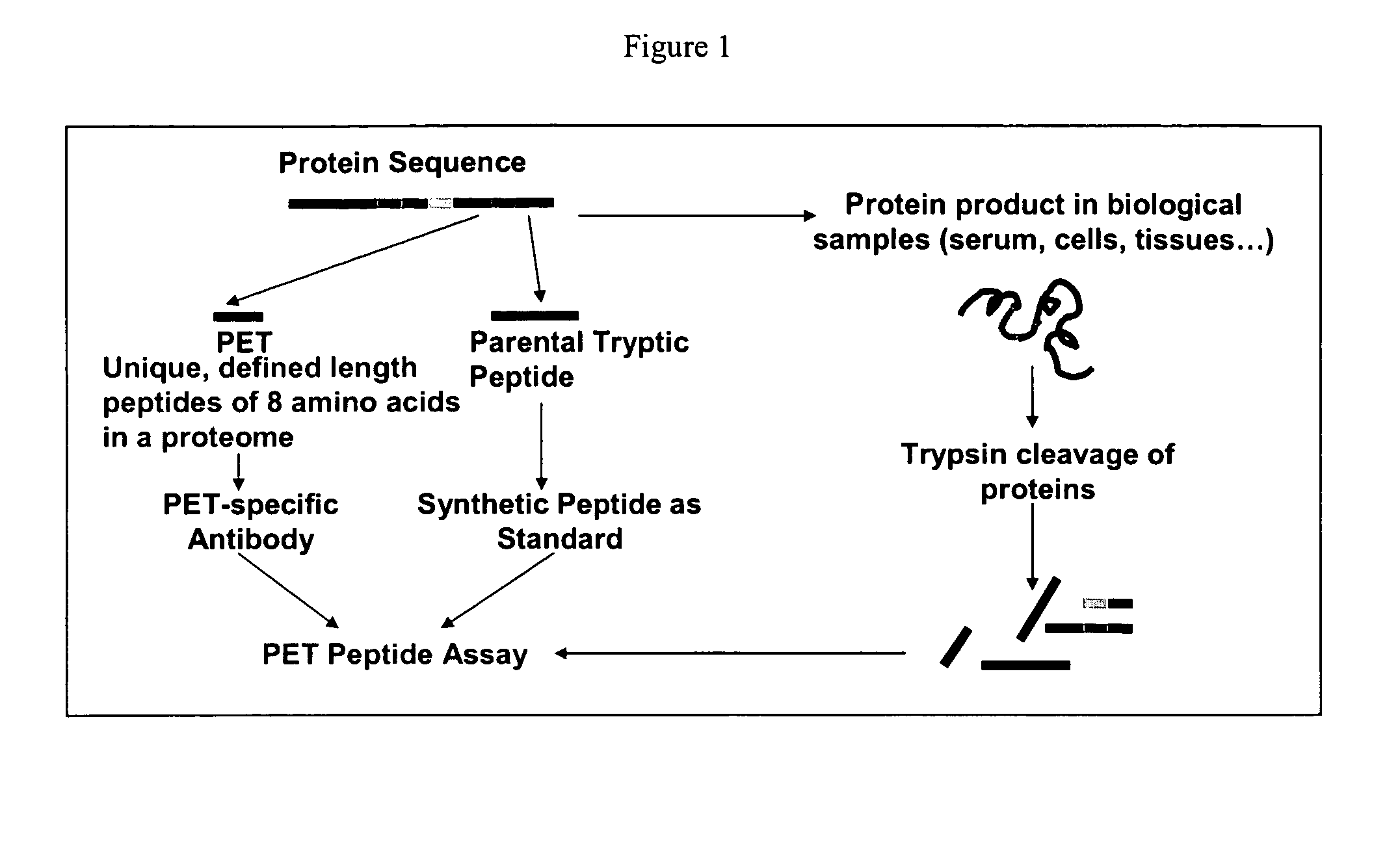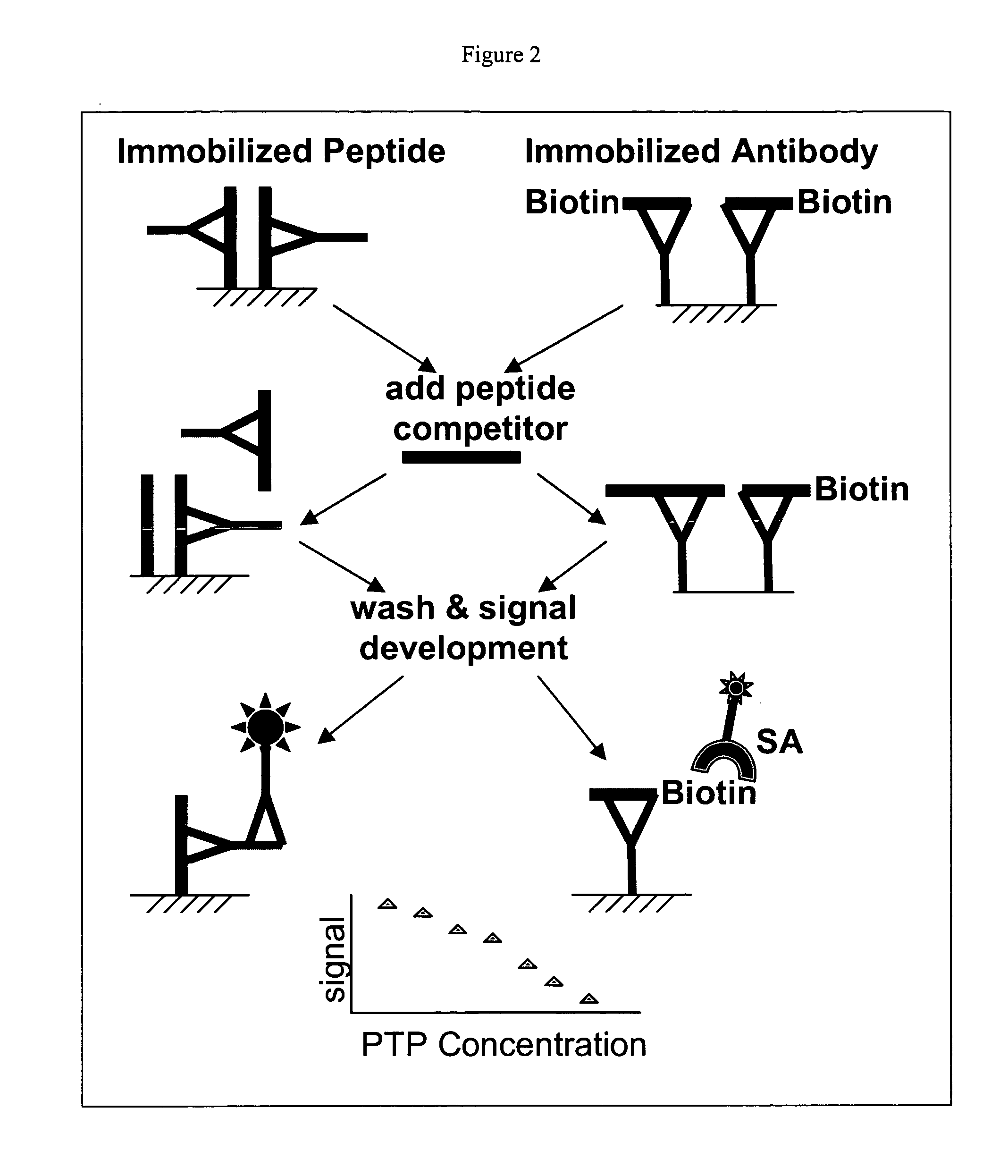Small molecule and peptide arrays and uses thereof
- Summary
- Abstract
- Description
- Claims
- Application Information
AI Technical Summary
Benefits of technology
Problems solved by technology
Method used
Image
Examples
example 1
Identification of Proteome Epitope Tags Within the Human Proteome
[0540] As any one of the total 20 amino acids could be at one specific position of a peptide, the total possible combination for a tetramer (a peptide containing 4 amino acid residues) is 204; the total possible combination for a pentamer (a peptide containing 5 amino acid residues) is 205 and the total possible combination for a hexamer (a peptide containing 6 amino acid residues) is 206. In order to identify unique recognition sequences within the human proteome, each possible tetramer, pentamer or hexamer was searched against the human proteome (total number: 29,076; Source of human proteome: EBI Ensembl project release v 4.28.1 on Mar. 12, 2002).
[0541] The results of this analysis, set forth below, indicate that using a pentamer as a unique recognition sequence, 80.6% (23,446 sequences) of the human proteome have their own unique recognition sequence(s). Using a hexamer as a unique recognition sequence, 89.7% of ...
example 2
Identification of Specific Pets
[0549]FIG. 15 outlines a general approach to identify all PETs of a given length in an organism with sequenced genome or a sample with known proteome. Briefly, all protein sequences within a sequenced genome can be readily identified using routine bioinformatic tools. These protein sequences are parsed into short overlapping peptides of 4-10 amino acids in length, depending on the desired length of PET. For example, a protein of X amino acids gives (X—N+1) overlapping peptides of N amino acids in length. Theoretically, all possible peptide tags for a given length of, for example, N amino acids, can be represented as 20N (preferably, N=4-10). This is the so-called peptide tag database for this particular length (N) of peptide fragments. By comparing each and every sequence of the parsed short overlapping peptides with the peptide tag database, all PET (with one and only one occurrence in the peptide tag database) can be identified, while all non-PET (w...
example 3
Identification of Sars-Specific Pets
[0554] The following example illustrates a general example of identifying organism-specific PET peptides. The same approach and procedures can be used for any other organisms, proteomes, or all the proteins within a specific protein sample.
Sequence Retrieval
[0555] A total of 2028 Coronavirus peptide sequences were obtained from the NCBI database (http: / / www.ncbi.nlm.nih.gov:80 / genomes / SARS / SARS.html). These sequences represent at least 10 different species of Coronavirus. Among them, 1098 non-redundant peptide sequences were identified. Each sequence that appeared identically within (was subsumed in) a larger sequence was removed, leaving the larger sequence as the representative. The resulting sequences were then broken up into overlapping regions of eight amino acids (8-mers), with a sequence difference of 1 amino acid between successive 8-mers. These 8-mers were then queried against a database consisting of all 8-mers similarly generated an...
PUM
| Property | Measurement | Unit |
|---|---|---|
| Fraction | aaaaa | aaaaa |
| Mass | aaaaa | aaaaa |
| Mass | aaaaa | aaaaa |
Abstract
Description
Claims
Application Information
 Login to View More
Login to View More - R&D
- Intellectual Property
- Life Sciences
- Materials
- Tech Scout
- Unparalleled Data Quality
- Higher Quality Content
- 60% Fewer Hallucinations
Browse by: Latest US Patents, China's latest patents, Technical Efficacy Thesaurus, Application Domain, Technology Topic, Popular Technical Reports.
© 2025 PatSnap. All rights reserved.Legal|Privacy policy|Modern Slavery Act Transparency Statement|Sitemap|About US| Contact US: help@patsnap.com



